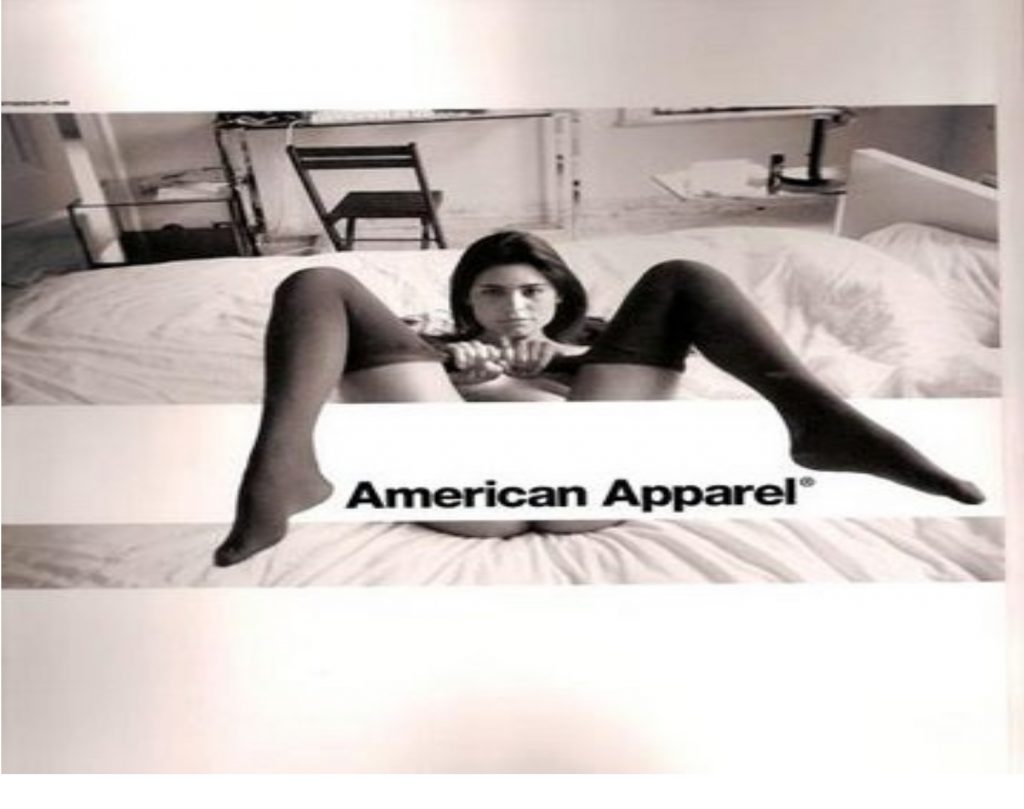Task 9/10: Ethical Issues in Fashion and Textiles Advertising
The advertisement for American Apparel is thought provoking and uncomfortable for some to observe but is however accepted and justified as a way to normalise the ethical issues and controversy surrounding it. The model is seen posing suggestively on a bed, the image in black and white with the company’s iconic label dignifying the models appearance, a simplistic yet powerful image that links strongly to stereotypical marketing and the objectification of women in modern day advertising. Living within a society, a world where sex sells, sexualising women is a common occurrence. This has resulted in women feeling victimised and viewed as a method in which to increase sales when directed at a certain audience, examples of this can be found in almost every magazine you will pick up in any store in any city in the world.
An article based on the journal ‘Sex Roles’ (a social and behavioural journal with a feminine perspective) discusses how women have been seen as sex objects and fallen victim to print advertisements. Focusing their attention on the contents of 58 different U.S magazines, statistics show that on average one in two advertisements that featured women showed them as sex objects and 10% portrayed women as victims, more likely appearing in men’s, women’s and fashion magazines than in the news or business focused material. The implication of viewing advertisements depicting this behaviour is discussed in more detail suggesting that women are portrayed in this way in order to make men feel more dominant and powerful – “At the very least, [such imagery in] advertising helps to create a climate in which certain attitudes and values flourish, such as the attitude that women are valuable only as objects of men’s desire, that real men are always sexually aggressive, that violence is erotic, and that women who are the victims of sexual assault ‘asked for it’” (Kilbourne 1999, pp. 290–91)[1].
This can be viewed as potentially disturbing for the future and how women will ultimately remain to be depicted due to how the media portrays them. Advertisement is such a common use of media that people no longer give any conscious attention towards what is being presented to them through the eyes of the advertisers. We accept what we feel is normal and what is common leading to stereotypes and trends being created that should not be encouraged or fuelled, despite this, we give into temptations and what we find appealing leading to these kind of ethical issues.
For instance, the women in the American Apparel advertisement is positioned in a way that will confidently grab someone’s attention but in no way does is make clear to said viewer what the brand is selling/ advertising, but in the advertisement industry this is not always seen as a priority, the initial attention has been received and in most instances this is all that is needed in order to make a lasting impression. The model presented in this same advertisement shares the same appearance of a stereotypical prostitute, this type of observation could reflect badly on the brands image and reputation but is overlooked due to the normalisation of these issues in today’s culture.
I feel that this shows the extent of how often women are objectified in the advertisement industry and how the social messages and suggestive actions are likely to be left unquestioned as people are so often exposed to this kind of media worldwide. Despite this, brands that inflict this kind of imagery into the media should be fully aware of the impact they are making and therefore should take full responsibility for the consequences made apparent by presenting their products in this way.
Bibliography:
[1] Stankiewicz, J. and Rosselli, F. (2017). Women as Sex Objects and Victims in Print Advertisements.






